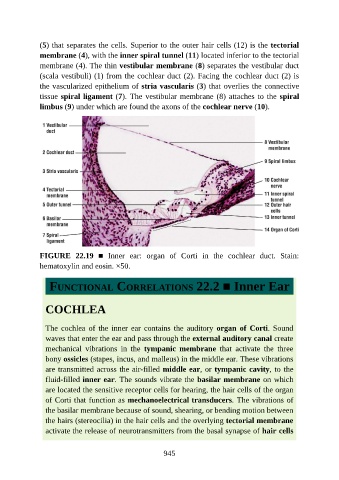Page 946 - Atlas of Histology with Functional Correlations
P. 946
(5) that separates the cells. Superior to the outer hair cells (12) is the tectorial
membrane (4), with the inner spiral tunnel (11) located inferior to the tectorial
membrane (4). The thin vestibular membrane (8) separates the vestibular duct
(scala vestibuli) (1) from the cochlear duct (2). Facing the cochlear duct (2) is
the vascularized epithelium of stria vascularis (3) that overlies the connective
tissue spiral ligament (7). The vestibular membrane (8) attaches to the spiral
limbus (9) under which are found the axons of the cochlear nerve (10).
FIGURE 22.19 ■ Inner ear: organ of Corti in the cochlear duct. Stain:
hematoxylin and eosin. ×50.
FUNCTIONAL CORRELATIONS 22.2 ■ Inner Ear
COCHLEA
The cochlea of the inner ear contains the auditory organ of Corti. Sound
waves that enter the ear and pass through the external auditory canal create
mechanical vibrations in the tympanic membrane that activate the three
bony ossicles (stapes, incus, and malleus) in the middle ear. These vibrations
are transmitted across the air-filled middle ear, or tympanic cavity, to the
fluid-filled inner ear. The sounds vibrate the basilar membrane on which
are located the sensitive receptor cells for hearing, the hair cells of the organ
of Corti that function as mechanoelectrical transducers. The vibrations of
the basilar membrane because of sound, shearing, or bending motion between
the hairs (stereocilia) in the hair cells and the overlying tectorial membrane
activate the release of neurotransmitters from the basal synapse of hair cells
945

